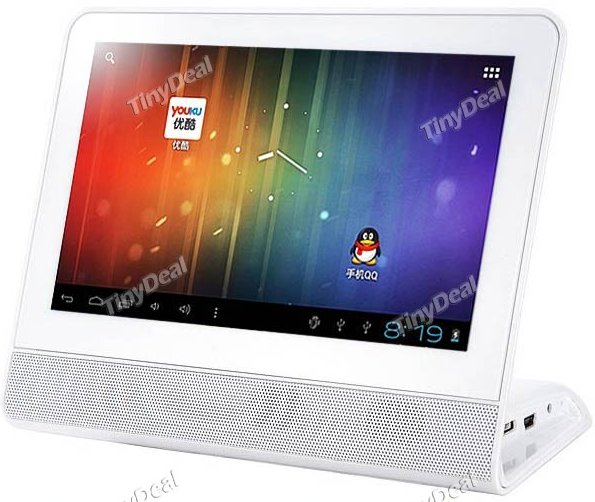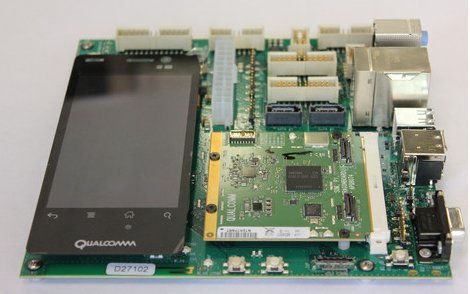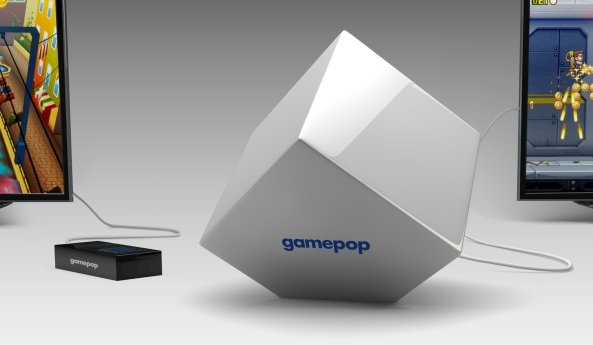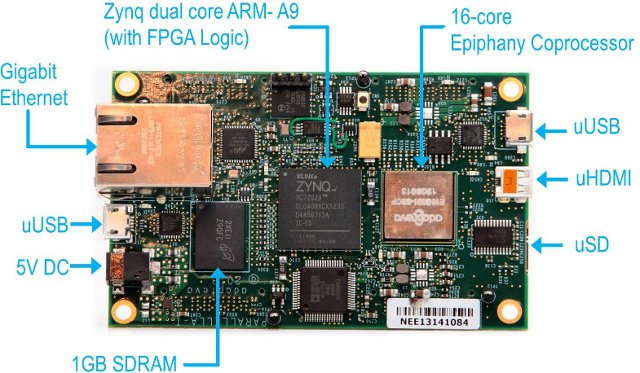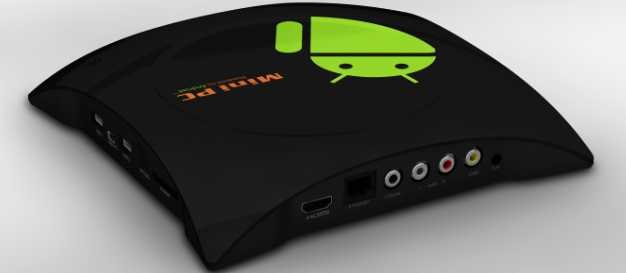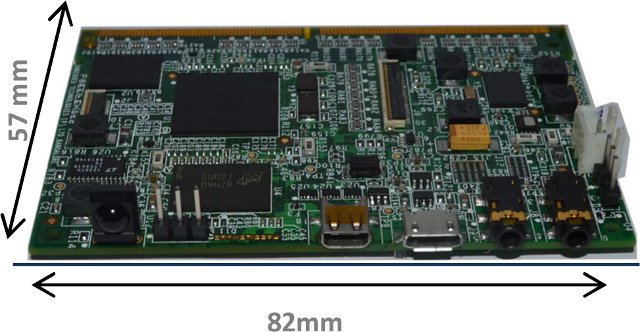The tablet shown below has pretty low specifications with an AllWinner A13 SoC, 512 MB RAM, 4GB, a 7″ 800×480 display, and a not so attractive price. However its stand makes it somewhat unique, and this tablet may be practical as a media frame, kitchen tablet, or possibly as an input console for some external device. Here are the specifications of the device: SoC – Allwinner A13 ARM Cortex-A8 Processor @ 1GHz with Mali-400 GPU System Memory – 512 MB Storage – 4GB NAND Flash + (full size) SD card slot Display – 7″ capacitive touchscreen TFT display with 800×480 resolution Connectivity – Wi-Fi 802.11 b/g/n Sensor – Gravity USB – mini USB port Battery – Unknown Audio – Built-in speaker This Android 4.0 tablet comes with a power adapter, an OTG cable, and a user’s manual. You can purchase it for $83.59 on TinyDeal, but if you really need […]
Intrinsyc Announces DragonBoard 8074 Devkit Based on Qualcomm Snapdragon 800 APQ8074 Processor
Intrinsyc Software has announced the availability of a new DragonBoard Development Kit composed of a Qseven Open-Q 8074 SoM powered by Qualcomm Snapdragon 800 APQ8074 processor for Android and embedded Linux development, and a mini-ITX carrier board. The kit is designed to help with developing applications such as ruggedized tablets, digital signage, applications for government/public safety, health care, robotics, wearable displays and video streaming/conferencing. Specifications of DragonBoard 8074 Kit: SoC – Qualcomm Snapdragon 800 (APQ8074) quad core Krait 400 CPU @ 2.3 GHz with Adreno 330 GPU and Hexagon v5 QDSP6 @ 600MHz System Memory – 2GB LPDDR3 RAM Storage – 16GB eMMC flash + micro SD slot + 2x SATA Display – qHD LCD capacitive touchscreen Connectivity: Gigabit Ethernet Wi-Fi 802.11n/ac Bluetooth 4.0 GNSS (GPS and GLONASS) Other I/O: USB – 2x USB 3.0 + 2x USB 2.0 + micro-AB USB OTG Video Output – HDMI Audio – 5.1 […]
ZTE Open, the First Firefox OS Phone, is Available in Spain
Phones based on alternative mobile operating systems (Firefox OS, Sailfish OS, Tizen…) are due to be available this year. The first entrant appears to be Telefonica ZTE Open, an entry level phone running Firefox OS that will be available in Spain on July 2, 2013 (Tomorrow). Here are the specifications of the device: SoC – Qualcomm MSM7225A ARM Cortex A5 @ 800Mhz System Memory – 256 MB RAM Storage – 512 MB ROM + micro SD card slot (4GB SD card included) Display – 3.5″ HVGA TFT, One Point touch + Gesture Captive (Two point option) Connectivity – Wi-Fi 802.11 b/g/n + Bluetooth 2.1 + GPS (with AGPS) Network – UMTS Sensors – Accelerometer, Ambient Light Camera – 3.2MP canera Battery – 1200mAH Dimensions – 114 × 62 × 12.5 mm This a low end device by today’s standard, but that’s exactly what Firefox OS is for. I’ve recently been […]
Bluestacks GamePop Mini is a Free Android Game Console (with Subscription)
The price of Android media devices keep getting lower months after months, and one company, BlueStacks, has gone a step further and decided to provide their GamePop Mini Android game console for free (excluding shipping), as long as you take a $6.99 monthly game subscription for a least a year. This is where I usually list the specifications, but today I’m just unable to do so, as there aren’t any. We just know the GamePop mini is less powerful than the company’s $129 GamePop, but it “will be able to handle all of your favorite apps and games plenty well, and there may also be more peripherals available for the GamePop.” GamePop specifications aren’t available either, but I guess the GamePop Mini might come with a dual core processor, and the GamePop will a quad core processor. The monthly subscription will allow you to download games without extra cost from […]
$99 Parallella Supercomputer is Now Open Source Hardware
Parallella is a low cost supercomputer designed by Adapteva using Xilinx Zynq-7010/7020 FPGA+2x Cortex A9 SoC combined with Adapteva Ephipany 16 or 64 cores epiphany coprocessor. The project had a successful kickstarter campaign which allowed then to provide the 16-core version for $99, and the 64-core version for $750. The board will soon be shipped to people who pledged on kickstarter, and one of the promise of the campaign was to fully open source the platform, and today, they just fulfilled that. Before going into the details of the open source release, let’s have a look at the specs: SoC – Xilinx Zynq7000 Series (Z-7010 or Z-7020) Dual-Core ARM Cortex A9 with 512KB L2 Shared Cache Coprocessor – Epiphany Multicore Coprocessor. The Parallella-16 board includes the 16-core Epiphany-III processor The Parallella-64 board includes the 64-core Epiphany-IV processor System Memory – 1024MB DDR3L Boot Flash – 128 Mb QSPI Flash Indicators […]
Lollybot is a $10 Robot Made with a USB Gamepad and Chupa Chups
I attended Barcamp Chiang Mai 6 yesterday, and sessions dealt with a wide range of subjects ranging from SEO and web development to things like nuclear energy, VMAT2 God gene, or Edward Snowden. There were just four talks somewhat related to the subjects I usually write about in this blog: Project Manhattan – An interactive TV infrastructure project for TV operators based on open source libraries (but not open source itself). They provide both back-end software and a mobile app (Android or iOS) for smartphones and set-top boxes. They had an Android set-top box, but unfortunately there was no time for demo. There’s no project website, but the solution is said to be used by horizon-tv.tv (in Russian). A Raspberry Pi session which I could not attend Firefox OS – Keng is the owner of a mobile and web development company called opendream, but he’s also one of the 4 […]
JW-11 Android or Linux Media Player Supports Internal 2.5″ Hard Drive
If you’re not simply watching movie streamed from the Internet, one way to store your media files is in a NAS, and another way is to store directly into your media player with an Hard drive. Unless you run a SAMBA or NFS server within your media player, you may lose the ability to access your files from several devices, but by playing directly from the hard drive, you are sure any video will be played smoothly. There are few low cost set-top box that support SATA, and the ones that do, such as Mele A1000 and its successors, simply offer an external SATA connector leaving your hard drive without protection from dust. I’ve just noticed there’s a low cost solution with an internal HDD enclosure thanks to an Android set-top box powered by Amlogic AML8726-M3 called either JW-11 or Slav, and maybe some other names I’ve missed. Here are […]
FossilShale FS-DM385-SOM Features TI DaVinci SoC for HD Media applications
FossilShale, an embedded company based in Bangalore, has announced a system-on-module based on Texas Instruments Davinci TMS320DM385 SoC that targets applications high-definition decoding and encoding (up to 1080p60) such as IP Cameras, HD video conferencing endpoints, digital signage, portable medical imaging and diagnostics, or camcorders. It can be used standalone for evaluation, or with a carrier board. FS-DM385-SOM Specifications: SoC – Texas Instruments TMS320DM385F ARM Cortex A8 core @ 1GHz with HDVICP v2 video core handling H.264 BP/MP/HP, MPEG2, VC1, MPEG4 SP/ASP, JPEG/MJPEG encoding and decoding. Memory – 1GB DDR3 Storage – 512MB NAND flash +1x Micro SD/MMC connector (up to 32GB) Audio / Video: 1x HDMI Out (Micro) 1x LCD TFT Interface (24 Bit RGB) 1x Camera Interface (MIPI) 1x Integrated Composite Video In & Audio Line In(Stereo Jack) 1x Integrated Composite Video Out & Audio Line Out(Stereo Jack) Other Interfaces: 1x USB OTG 1x IrDA Accelerometer 1x I2C, 1x SPI […]


